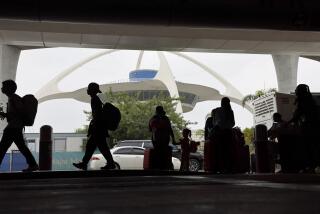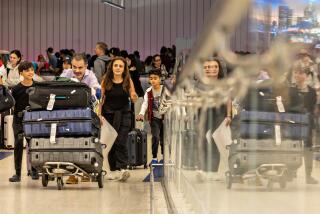Airport Security Arrives on Time
WASHINGTON — The government’s hurried, $6-billion overhaul of airport security will meet a major goal today as white-shirted federal screeners take over the job of checking passengers around the country.
As recently as the summer, many doubted that the new Transportation Security Administration could hire, train and deploy more than 30,000 passenger screeners by a Tuesday deadline set by Congress in response to last year’s terrorist attacks.
The TSA will meet that goal a day early, a spokeswoman said. The turnaround, while welcome, is winning mostly guarded praise and an incomplete grade. By the end of the year, the TSA must meet the bigger challenge of screening all checked luggage with explosives detection technology. Furthermore, there is still no system for screening airline cargo, a glaring loophole.
“The passenger screening system that we had before was unreliable at best, and today our cargo screening system is certainly not in any kind of shape,” said Sen. Kay Bailey Hutchison, (R-Texas), new chairwoman of the aviation subcommittee.
With reports that Al Qaeda leader Osama bin Laden is at large and still a threat, and with many security improvements yet to be completed, some government officials don’t want to overplay accomplishments.
“There is a positive, but wait-and-see attitude about TSA,” said Gerald Dillingham, director of aviation issues for the General Accounting Office, the watchdog agency of Congress.
Before the Sept. 11 attacks on the World Trade Center and the Pentagon, passenger screening was a dead-end job. Screeners were minimum-wage employees of private security companies, under contract to the airlines. They typically stayed just a few months before seeking better-paying work. There was little incentive to sharpen skills or develop a commitment to the job.
The federal screeners are better trained and earn $23,600 to $35,400 a year, plus benefits. They are part of a law enforcement organization that already spans the country. They have a career path available that can lead to more senior jobs in the TSA or in government.
Frequent fliers say the early line on TSA screeners is that they are polite, thorough -- and numerous. Travelers report airport checkpoints swarming with white shirts.
Todd Hauptli, an airline association lobbyist, recalled an experience last week at a TSA-staffed checkpoint in the Salt Lake City airport. He was asked to take his shoes off so they could be tested for explosives.
“They yelled for a bin runner and three guys bumped into each other trying to get to me first,” Hauptli said. “The staffing levels can most charitably be described as generous.”
Some lawmakers are concerned about overstaffing at the agency. “There’s way too many of them,” said Rep. Harold Rogers (R-Ky.), a critic of the $6.6-billion TSA budget. “They have flooded these airports with screeners and that work force needs to slim down immediately.”
But TSA officials say many checkpoints are being simultaneously used for training. New screeners get 60 hours of on-the-job training, in addition to 44 hours in the classroom. The staffing level will eventually go down to five or six per checkpoint lane, TSA spokesman Robert Johnson said.
Many at the TSA believe the agency’s accomplishments have not gotten due recognition.
“We put our first passenger screeners on the line April 30 in Baltimore,” Johnson said. “You have to give us a little bit of credit here for the magnitude of the job we undertook and the things we’ve accomplished so far. We are not done, but we are doing what we said we were going to do.”
Federal passenger screeners already have taken over at Los Angeles International and John Wayne airports. With 1,600 screeners, LAX has the biggest force of any airport in the country. Both airports also are on track to meet the Dec. 31 deadline for screening checked luggage with explosives detection technology, which will require 22,000 more TSA screeners.
Hiring staff does not seem to be a problem, but airline and airport officials fear there will be long lines of passengers waiting to have their luggage screened in ticket lobbies. The crowds could become a target for terrorists, security experts warn.
Crowding could arise because a significant proportion of checked luggage will have to be opened for testing. This will be particularly true at airports using a technology called Trace detection. A sensor checks for explosives residue on a swab that a screener has applied to the bag or its contents.
Orange County’s John Wayne is among a minority of airports that will rely almost exclusively on another, more automated concept. CT (computed tomography) scanners will be built into the airport’s baggage conveyor system. Akin to those used by doctors to diagnose tumors, the scanners let operators see into a closed bag. Bags have to be opened only if they trigger an alarm that the operator cannot resolve with closer inspection.
LAX plans to use a combination of Trace and CT scanners in all its terminals, spokesman Paul Haney said.
Both systems have drawbacks. Current CT scanners are notoriously prone to false alarms, and Trace testing is time-consuming and labor-intensive. Neither is viewed as an ideal, permanent solution.
“From the models I’ve seen, people are going to be out to the curbside at some airports,” said Cathal Flynn, a former Federal Aviation Administration security chief. “Having people for extended periods of time in the lobbies subjects them to the risk of being bombed right there.”
The homeland security bill pending in Congress would allow the TSA to postpone the luggage deadline one year on an airport-by-airport basis, provided that backup measures are in place. TSA director James M. Loy has said that probably no more than 5% of the nation’s 429 commercial airports will get extensions. However, they are likely to be facilities with a high volume of passengers, such as Dallas-Fort Worth International Airport.
Luggage screening is far along, however, when compared with cargo. Airlines transport mail and just about anything that can be safely stowed in the belly of a plane, and cargo accounts for about 10% of the cash-starved industry’s revenue.
Some precautionary measures have been taken. Mail is limited to letters and parcels weighing less than 16 ounces. The TSA and the airlines are working closely with shippers to improve internal security procedures. A basic principle is that the airlines deal only with “known shippers” that have an established track record. Nonetheless, experts say the safeguards fall well short of the level of screening accorded to passengers and their bags.
“Cargo is probably the most significant gap there is,” the GAO’s Dillingham said. “We screen all passengers and their carry-on bags, but there is very little screening of cargo.”
The government also has yet to mandate the use of bomb-resistant cargo and luggage containers that can go in the belly of an aircraft. The FAA has tested and approved containers built by two U.S. companies, but the airlines are unlikely to buy them without a government requirement and funding. Overseas, Israel’s El Al Airlines uses bomb-resistant containers.
Hutchison has tried to move legislation in the Senate to improve cargo security, but final passage will have to wait until the new Congress next year. “Cargo legislation will be our highest priority,” she said.
Other elements of the security system that still are under development include a computerized profiling system for passengers, a trusted traveler program for those who agree to background checks, and the training of pilots to carry firearms for cockpit defense.
Former FAA security chief Flynn says security spending may reach $10 billion a year by the time all is said and done.
Like many members of Congress, Rep. Peter A. DeFazio (D-Ore.), a senior member of the House Transportation Committee, is constantly jetting around the country. He analyzes airport security from the vantage point of one who is privy to classified information about its strengths and weaknesses.
“I am very impressed with the consistency and the thoroughness of the TSA screeners,” he said. “The are doing a much better job than the lackadaisical screeners of the past. [But] we’ve probably done about 40% of what we need to do. On the other 60%, we’re not as vulnerable, but it’s spotty.”
More to Read
Inside the business of entertainment
The Wide Shot brings you news, analysis and insights on everything from streaming wars to production — and what it all means for the future.
You may occasionally receive promotional content from the Los Angeles Times.










